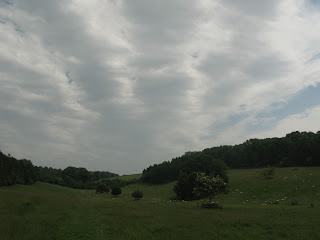I grabbed the last space at the Telegraph Hill car-park, on the junction of the B3078 and B3080, a few miles outside of Downton, Salisbury. It was a typical New Forest scene; a small yet busy roadside spot for hikers to gather before taking various trails and adventures. I picked up my Crimson Short Walks guide, and took a left out of the car-park onto the road and left along a wide gravel track.
Along with the sweltering sun, the open heathland reminded me a lot of the desert in New Mexico, through with the addition of New Forest ponies. I loved it when the sound of the traffic faded away and left me with miles of quiet, blissful wilderness, though it wouldn’t have always been like this.
In the mid-1940s, the Ashley Walk bombing range housed several bunkers and walls for testing bombs and methods of delivery. Dr Barnes Wallis’ bouncing bombs were tested on the No 3 wall, including the initial Highball bomb and the later “Upkeep” bomb used in the famous Dam Raids. The range is now empty, save a few craters and a small brick hut which might have been a viewing post. I later researched and found a great video from the Imperial War Museum; a succession of tests from 1943 of the Highball bomb.
I turned left and followed a way marked cycle track through the managed, man-made woodland of Amberwood and Islands Thorns Inclosures. I stopped by a stream to have my lunch, and enjoyed the peace and quiet, before continuing the winding path out of woodland to Fritham village green. Here, I passed a late-19th century post-box created to save the postman, who delivered and collected mail to and from the nearby Schultze Gunpowder Factory at the bottom of the hill, a ½ mile round trip.
I continued down the hill and came upon Eyeworth Pond, which was serene, and might have made a better picnic stop. I crossed a bridge and followed a track past Oaktree Cottage into a dense wood. I stopped to take pictures of some Fox-gloves, before following the winding path back to heathland. I got turned around and thought I was walking the wrong track, but after doubling back I realised I was headed the right way, and at a junction of paths turned left downhill, then back up towards my car.
You can read more about the Number 3 wall and Highball bomb testing on the New Forest Remembers website, a site dedicated to the New Forest’s importance in WWII.
The New Forest Explorers Guide also has some great information on the Ashley Walk bombing range.
This walk was from Crimson Short Walks, the New Forest National Park guide (number 19, Around the Islands). It’s a great guide with clearly detailed OS maps for each walk. Check it out on Amazon.



















































